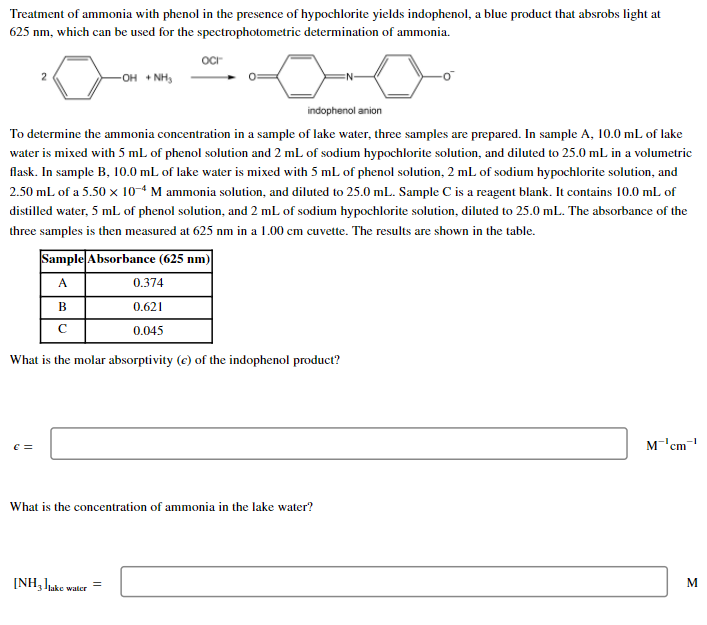625 nm, which can be used for the spectrophotometric determination of ammonia. ocr -OH • NH, indophenol anion To determine the ammonia concentration in a sample of lake water, three samples are prepared. In sample A, 10.0 mL of lake water is mixed with 5 mL of phenol solution and 2 ml of sodium hypochlorite solution, and diluted to 25.0 mL in a volumetric flask. In sample B, 10.0 mL of lake water is mixed with 5 mL. of phenol solution, 2 mL of sodium hypochlorite solution, and 2.50 mL of a 5.50 × 104 M ammonia solution, and diluted to 25.0 mlL. Sample C is a reagent blank. It contains 10.0 ml. of distilled water, 5 mL of phenol solution, and 2 mL of sodium hypochlorite solution, diluted to 25.0 mL. The absorbance of the three samples is then measured at 625 nm in a 1.00 cm cuvette. The results are shown in the table. Sample Absorbance (625 nm) A 0.374 B 0.621 0.045 What is the molar absorptivity (e) of the indophenol product? M'cm What is the concentration of ammonia in the lake water? [NH,Jhtc water M
625 nm, which can be used for the spectrophotometric determination of ammonia. ocr -OH • NH, indophenol anion To determine the ammonia concentration in a sample of lake water, three samples are prepared. In sample A, 10.0 mL of lake water is mixed with 5 mL of phenol solution and 2 ml of sodium hypochlorite solution, and diluted to 25.0 mL in a volumetric flask. In sample B, 10.0 mL of lake water is mixed with 5 mL. of phenol solution, 2 mL of sodium hypochlorite solution, and 2.50 mL of a 5.50 × 104 M ammonia solution, and diluted to 25.0 mlL. Sample C is a reagent blank. It contains 10.0 ml. of distilled water, 5 mL of phenol solution, and 2 mL of sodium hypochlorite solution, diluted to 25.0 mL. The absorbance of the three samples is then measured at 625 nm in a 1.00 cm cuvette. The results are shown in the table. Sample Absorbance (625 nm) A 0.374 B 0.621 0.045 What is the molar absorptivity (e) of the indophenol product? M'cm What is the concentration of ammonia in the lake water? [NH,Jhtc water M
Principles of Instrumental Analysis
7th Edition
ISBN:9781305577213
Author:Douglas A. Skoog, F. James Holler, Stanley R. Crouch
Publisher:Douglas A. Skoog, F. James Holler, Stanley R. Crouch
Chapter9: Atomic Absorption And Atomic Fluorescence Spectrometry
Section: Chapter Questions
Problem 9.1QAP
Related questions
Question

Transcribed Image Text:Treatment of ammonia with phenol in the presence of hypochlorite yields indophenol, a blue product that absrobs light at
625 nm, which can be used for the spectrophotometric determination of ammonia.
ocr
-OH • NH,
indophenol anion
To determine the ammonia concentration in a sample of lake water, three samples are prepared. In sample A, 10.0 mL of lake
water is mixed with 5 mL of phenol solution and 2 mL of sodium hypochlorite solution, and diluted to 25.0 mL in a volumetric
flask. In sample B, 10.0 mL of lake water is mixed with 5 mL. of phenol solution, 2 mL of sodium hypochlorite solution, and
2.50 mL of a 5.50 x 10-4 M ammonia solution, and diluted to 25.0 mL. Sample C is a reagent blank. It contains 10.0 mL of
distilled water, 5 mL of phenol solution, and 2 ml. of sodium hypochlorite solution, diluted to 25.0 mL. The absorbance of the
three samples is then measured at 625 nm in a 1.00 cm cuvette. The results are shown in the table.
Sample Absorbance (625 nm)
A
0.374
В
0.621
0.045
What is the molar absorptivity (c) of the indophenol product?
e =
M'cm
What is the concentration of ammonia in the lake water?
(NH, lake water
M
Expert Solution
This question has been solved!
Explore an expertly crafted, step-by-step solution for a thorough understanding of key concepts.
This is a popular solution!
Trending now
This is a popular solution!
Step by step
Solved in 3 steps with 2 images

Knowledge Booster
Learn more about
Need a deep-dive on the concept behind this application? Look no further. Learn more about this topic, chemistry and related others by exploring similar questions and additional content below.Recommended textbooks for you

Principles of Instrumental Analysis
Chemistry
ISBN:
9781305577213
Author:
Douglas A. Skoog, F. James Holler, Stanley R. Crouch
Publisher:
Cengage Learning

Principles of Instrumental Analysis
Chemistry
ISBN:
9781305577213
Author:
Douglas A. Skoog, F. James Holler, Stanley R. Crouch
Publisher:
Cengage Learning